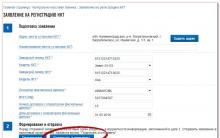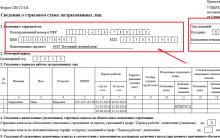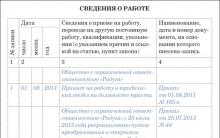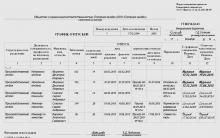Cash discipline requires all entrepreneurs, when performing transactions involving the acceptance of funds, to fill in cash receipt orders.
These primary accounting documents confirm the receipt of payment at the cash desk and help track cash inflows. At the same time, filling out the receipt document requires strict adherence to the norms prescribed by law.
Form KO-1
A cash receipt order (PKO) is a primary document where information is entered upon receipt of cash at the cash desk. As a rule, at the beginning of the financial year, the accountant or cashier of the company acquires an album of unified forms, which is a filing of forms of credit and debit orders. Throughout the year, he withdraws them to account for cash transactions.
It should be noted that the standard credit order in accounting practice is called the KO-1 form and is filled out for each operation in a single copy.
purpose
In the course of the activity of any company, cash can be poured into the cash desk of the company from the following sources:
- in the form of sales proceeds;
- from a bank account;
- after the sale of the property;
- in the form of refunds of unused funds;
- in order to pay fines;
- from the founders in the process of investing in the authorized capital.
Upon completion of all the listed operations, cash receipts are issued. Together with them, a tear-off receipt is also issued, which is handed over to the person who provided the cash to the cashier.
The PKO must indicate the source of the inflow of funds and their amount for each individual transaction.
This allows not only to comply with the cash discipline prescribed by law, but also to keep a competent account of cash flow at the enterprise.
Legislation
The procedure and mandatory requirements for filling out incoming cash orders are detailed in the regulation of the Central Bank of the Russian Federation, which is called the "Procedure for conducting cash transactions in the Russian Federation." This act entered into force in 1993 and since then, it is the KO-1 form that has served as the main document for accounting for cash receipts at the cash desk.
Articles 13,19,20,21 of this document describe how to correctly fill out the PKO and tear-off receipts when accepting funds. The importance of confirmation signatures is also emphasized here. So, the cashier or other authorized person puts a personal signature on each receipt paper, thereby confirming its authenticity. For legal entities, it is mandatory to certify each PKO with a seal.
In 1998, the State Statistics Committee of the Russian Federation issued Decree No. 88, in which it finally legalized the PKO as a unified document for the primary accounting of cash transactions.
How to fill out an incoming cash order?

Filling out the receipt document is a fairly simple procedure. The authorized person enters reliable data in the required fields, and marks empty lines with dashes.
Registration of PKO is carried out only after the receipt of the amount of cash and their piece counting in the presence of the person who provided them. The actual amount is entered into the document, the money goes to the cash desk and the personal signature of the accountant is affixed to the warrant.
Who fills out?
According to the law, the receipt document has the right to fill out an accountant or cashier, who take responsibility for the accuracy of the data entered in the fields of the form. If the company operates in the form of an individual entrepreneur and does not have financial employees, then the owner of the business fills in the credit slips.
The procedure for issuing a PKO can be represented as the following sequence of operations:
- Funds are transferred to the firm by a specific person;
- The cashier counts the cash and fills in the credit slip and tear-off receipt;
- After registration in the accounting journal, a tear-off receipt is issued to the person who transferred the funds to the cash desk;
- The cashier signs the receipt document, indicates his full name in it. and certifies it with a seal, if any, in the company.
It should be noted that the seal on the PKO is placed so that it touches the edges of both the receipt and the receipt document.
Mandatory details of the receipt order
Since the receipt order is an element of cash discipline, it has mandatory details, including:
- Fields for indicating the registration number of the document and the date of its completion;
- Places for entering the name of the company, its OKPO and the structural unit that accepted the funds;
- Fields where the name of the payer or his full name, as well as the number of the corresponding account are written;
- Column to indicate the source of funds and their amount.
As for the tear-off receipt, it has the same fields as in the main document, therefore, the information should simply be duplicated.
The process of filling out the PKO
Starting to fill out the PKO, you should indicate the name of the organization in the first line, and under it - the structural unit into which the cash was received. If the company is small and operates as an individual entrepreneur, then a dash can be put in the line "Structural division".
As for the OKPO and OKUD codes, they can be viewed in the certificate of the State Statistics Committee. The mark "Document number" determines the position of the PKO in the registration log. Orders are numbered sequentially from the beginning of the financial year.

In the column "Date of compilation" indicate the day, month and year. And this is done in Arabic numerals, which are separated by dots. If it happens that the first number consists of one character, then zero is assigned before it. The date indicated in the receipt document shows the exact moment of receipt of money at the cash desk, which is very important in the accounting policy of the company.
The main columns of the PKO are debit and credit. The order in which they are filled is as follows:
- For debit, the number of the account or sub-account on which funds are received is written.
- For a loan - the code of the structural unit that received the funds, or the enterprise itself, as well as a subaccount and analytical accounts, if such an accounting system is adopted in the organization.
All empty cells of the table must be closed with dashes.
In the graph "Sum" the exact amount of cash received in rubles and kopecks is written in numbers. The last column is filled in if such a system is used by the company: it indicates exactly where the cash is directed. If after specifying the amount in the line there is an empty gap, then it is closed with a dash. The line below calculates the inflow net of VAT.
In the lines under the main table, the full name is entered. the person from whom the funds were received, as well as the source of their receipt. For example, payment for goods and services, return of unused cash, fine, etc.
Various kinds of primary documents, if any, are described in the "Appendix" column. As a rule, these papers serve as the basis for issuing an order and are subsequently attached to it.
All information specified in the PKO is accurately duplicated on a tear-off receipt, after which the accountant or cashier certifies the document with his signature with its detailed transcript. Full name is also indicated here. the person who filled out the form.
See here for an example of how to fill out an incoming cash receipt. It clearly presents all the nuances of the design of the PKO:

Completing the PQS online and electronically

Taking into account the fact that most companies now keep their books in electronic form, the law does not prohibit filling out PQS on a computer in special programs.
The most famous accounting electronic services are now considered to be such developments created by 1C companies as:
- INFO-Accountant;
- Galaxy;
- Sail;
- ABACUS and others.
You can also fill out an incoming cash order online through such popular services as My Business, Buhonline and SKB-Kontur. Working in them, the cashier simply makes entries in the main part of the order, and the information is immediately automatically duplicated on a tear-off receipt and registers the document in an electronic journal, assigning a number to it.
Thus, filling in receipt documents online can provide a cashier or accountant with advantages over their usual paperwork.
They are as follows:
- Saving time, since the data registered once is automatically copied to the tear-off receipt and to the register of primary papers.
- The ability to avoid mistakes and correct them in a timely manner.
- The archive of documents is generated automatically, which means that at the end of the year you can print all the PQS at once in chronological order.
- The presence of automatic numbering of documents allows you to exclude various kinds of fraudulent transactions;
- Order pages can be stored in Excel and PDF format.
If a company practices keeping a cash book in electronic form, then the system of online filling out the PKO can be associated with it, which will ensure its automatic filling.
It should be noted that at the end of the year all PQS are printed out and filed in a separate folder, where they are stored for 5 years.
Accounting and storage
The main milestones in the accounting of primary documents in modern enterprises are:
- Journal of accounting for PKO and RKO.
- Filing with receipt documents.
- Cash book.
At the end of each day, all orders are entered into the cash book. Based on them, information is generated on the inflow and outflow of funds and their balance is displayed at the cash desk.
As noted earlier, upon discharge, the PKO is registered in the ledger under an individual serial number. At the end of the year, it is for this purpose that all inflows of funds to the enterprise are reconciled. After registration, all incoming documents are filed in a separate folder with a binder in chronological order. At the end of the folder, a final sheet should be inserted, in which, signed by the accountant, it is indicated exactly how many papers were issued during the year and filed into the folder.
It should be noted that the cash discipline of 2014 eliminates the need for conducting PKO and RKO by firms operating as individual entrepreneurs. However, from the point of view of increasing the efficiency of intra-company accounting, this practice is still very appropriate.
At the end of the financial year, the accounting journal, the binder with PKO and the cash book are closed and stored at the enterprise for five years. The details of all three documents must match exactly.
If an error was made while filling the order

The procedure for issuing PKOs regulated by law prohibits the presence of any kind of errors in this document. That is why any blots and corrections will entail the need to completely rewrite the order.
In the practice of accounting activities, there are cases when the PQS is issued without blots, while it contains the following inconsistencies:
- Violated standard filling rules;
- Not everywhere there are signatures of an authorized person;
- Invalid, incorrect or illegible amount.
If these inaccuracies are found, the document will also have to be reissued. This aspect is especially relevant for large enterprises, where cash receipts are issued by the cashier, and the chief accountant certifies them.
Thus, the procedure for issuing receipt orders is not fraught with serious difficulties, the main thing is to enter reliable data in the designated fields and monitor the correct execution of these primary documents. At the end of the month, it is advisable to check all issued PKOs with entries in the cash book in order to identify inaccuracies in the financial accounting of the company in time even before the end of the financial year.











How to issue a power of attorney to represent the interests of an LLC to an individual?
How to apply for an IP: step by step instructions
Form of power of attorney to receive goods or material assets
The deadline for registering an individual entrepreneur in the tax
Business plan for a law firm: an example with calculations legal support for a business